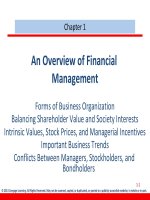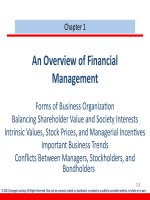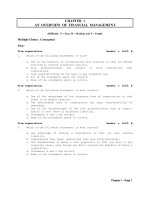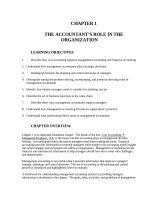Management 12e richard draft chapter 01
Bạn đang xem bản rút gọn của tài liệu. Xem và tải ngay bản đầy đủ của tài liệu tại đây (810.59 KB, 25 trang )
Chapter 1
Innovative Management for a
Changing World
© 2016 Cengage Learning. All Rights Reserved. May not be scanned, copied or duplicated, or posted to a publicly accessible website, in whole or in part.
Innovative Management for
the New Workplace
Rapid environmental shifts:
Technology
Globalization
Shifting social values
In the new workplace, work is
free-flowing and
flexible
Success depends on innovation and continuous improvement
2
© 2016 Cengage Learning. All Rights Reserved. May not be scanned, copied or duplicated, or posted to a publicly accessible website, in whole or in part.
New Management Competencies
Managers
do more with less
engage hearts and minds
see change as natural
inspire vision and cultural values
allow people to create a collaborative workplace
allow people to create a productive workplace
3
© 2016 Cengage Learning. All Rights Reserved. May not be scanned, copied or duplicated, or posted to a publicly accessible website, in whole or in part.
Management Competencies
for Today’s World
Management is the attainment of organizational goals in an effective
and efficient manner through planning, organizing, leading, and
controlling organizational resources
Today’s effective manager is an enabler who helps people do and be
their best.
Today’s best managers are “future-facing.”
Managers employ an empowering leadership style.
4
© 2016 Cengage Learning. All Rights Reserved. May not be scanned, copied or duplicated, or posted to a publicly accessible website, in whole or in part.
1.1 State-of-the-art Management
I
5
© 2016 Cengage Learning. All Rights Reserved. May not be scanned, copied or duplicated, or posted to a publicly accessible website, in whole or in part.
1.2 What Do Managers Do?
6
© 2016 Cengage Learning. All Rights Reserved. May not be scanned, copied or duplicated, or posted to a publicly accessible website, in whole or in part.
1.3 The Process of Management
7
© 2016 Cengage Learning. All Rights Reserved. May not be scanned, copied or duplicated, or posted to a publicly accessible website, in whole or in part.
Organizational Performance
Organization: Social entity that is goal directed and deliberately
structured
Organizational effectiveness: Providing a product or service that
customers value
Organizational efficiency: Refers to the amount of resources used to
achieve an organizational goal
8
© 2016 Cengage Learning. All Rights Reserved. May not be scanned, copied or duplicated, or posted to a publicly accessible website, in whole or in part.
Management Skills
Three categories of skills: conceptual, human, technical
The degree of the skills may vary but all managers must possess the
skills
The application of management skills change as managers move up the
hierarchy
9
© 2016 Cengage Learning. All Rights Reserved. May not be scanned, copied or duplicated, or posted to a publicly accessible website, in whole or in part.
1.4 Relationship of
Skills to Management
10
© 2016 Cengage Learning. All Rights Reserved. May not be scanned, copied or duplicated, or posted to a publicly accessible website, in whole or in part.
1.5 Good Behaviors for Managers
11
© 2016 Cengage Learning. All Rights Reserved. May not be scanned, copied or duplicated, or posted to a publicly accessible website, in whole or in part.
When Skills Fail
Missteps and unethical behavior have been in the news
During turbulent times, managers must apply their skills
Common management failures:
Not listening to customers
Unable to motivate employees
Not building teams
Inability to create cooperation
Failure to clarify performance expectations
Poor communication and interpersonal skills
12
© 2016 Cengage Learning. All Rights Reserved. May not be scanned, copied or duplicated, or posted to a publicly accessible website, in whole or in part.
1.6 Top Causes of
Manager Failure
13
© 2016 Cengage Learning. All Rights Reserved. May not be scanned, copied or duplicated, or posted to a publicly accessible website, in whole or in part.
Management Types: Vertical
Top managers: Responsible for the entire organization
Middle managers: Responsible for business units
Project managers: Responsible for misinterpreting signals
First-line managers: Responsible for production of goods and services
14
© 2016 Cengage Learning. All Rights Reserved. May not be scanned, copied or duplicated, or posted to a publicly accessible website, in whole or in part.
1.7 Management Levels
15
© 2016 Cengage Learning. All Rights Reserved. May not be scanned, copied or duplicated, or posted to a publicly accessible website, in whole or in part.
Management Types: Horizontal
Functional managers: Responsible for departments that perform
specific tasks
General managers: Responsible for several departments
16
© 2016 Cengage Learning. All Rights Reserved. May not be scanned, copied or duplicated, or posted to a publicly accessible website, in whole or in part.
Making the Leap: Becoming
a New Manager
Organizations often promote star performers to management
Many new managers expect more freedom to make changes
Becoming a manager is a transformation
Move from being a doer to a coordinator
Successful managers build teams and networks
Many make the transformation in a “trial by fire”
17
© 2016 Cengage Learning. All Rights Reserved. May not be scanned, copied or duplicated, or posted to a publicly accessible website, in whole or in part.
1.8 Making the Leap from Individual Performer to
Manager
18
© 2016 Cengage Learning. All Rights Reserved. May not be scanned, copied or duplicated, or posted to a publicly accessible website, in whole or in part.
Do You Really Want
to Be a Manager?
The increased workload
The challenge of supervising former peers
The headache of responsibility for other people
Being caught in the middle
19
© 2016 Cengage Learning. All Rights Reserved. May not be scanned, copied or duplicated, or posted to a publicly accessible website, in whole or in part.
Manager Activities
Adventures in multitasking
Activity characterized by variety, fragmentation, and brevity
Less than nine minutes on most activities
Managers shift gears quickly
Life on speed dial
Work at unrelenting pace
Interrupted by disturbances
Always working (catching up)
20
© 2016 Cengage Learning. All Rights Reserved. May not be scanned, copied or duplicated, or posted to a publicly accessible website, in whole or in part.
Manager Roles
Role: Set expectations for a manager’s behavior
Every role undertaken by a manager accomplishes the functions of:
Planning
Organizing
Leading
Controlling
21
© 2016 Cengage Learning. All Rights Reserved. May not be scanned, copied or duplicated, or posted to a publicly accessible website, in whole or in part.
1.9 Ten Manager Roles
22
© 2016 Cengage Learning. All Rights Reserved. May not be scanned, copied or duplicated, or posted to a publicly accessible website, in whole or in part.
Manager Roles
Manager roles are important to understand but they are not discrete
activities
Management cannot be practiced as independent parts
Managers need time to plan and think
23
© 2016 Cengage Learning. All Rights Reserved. May not be scanned, copied or duplicated, or posted to a publicly accessible website, in whole or in part.
1.10 Hierarchical Levels and
Importance of Leader and Liaison Roles
24
© 2016 Cengage Learning. All Rights Reserved. May not be scanned, copied or duplicated, or posted to a publicly accessible website, in whole or in part.
Managing in Small Business and Nonprofit
Organizations
Small businesses are growing
Nonprofits need management talent
Inadequate management skills is a threat
The roles for small business managers differ
Entrepreneurs must promote the business
Apply the four functions of management to make social impact
More focus on keeping costs low
Need to measure intangibles like “improving public health”
25
© 2016 Cengage Learning. All Rights Reserved. May not be scanned, copied or duplicated, or posted to a publicly accessible website, in whole or in part.









